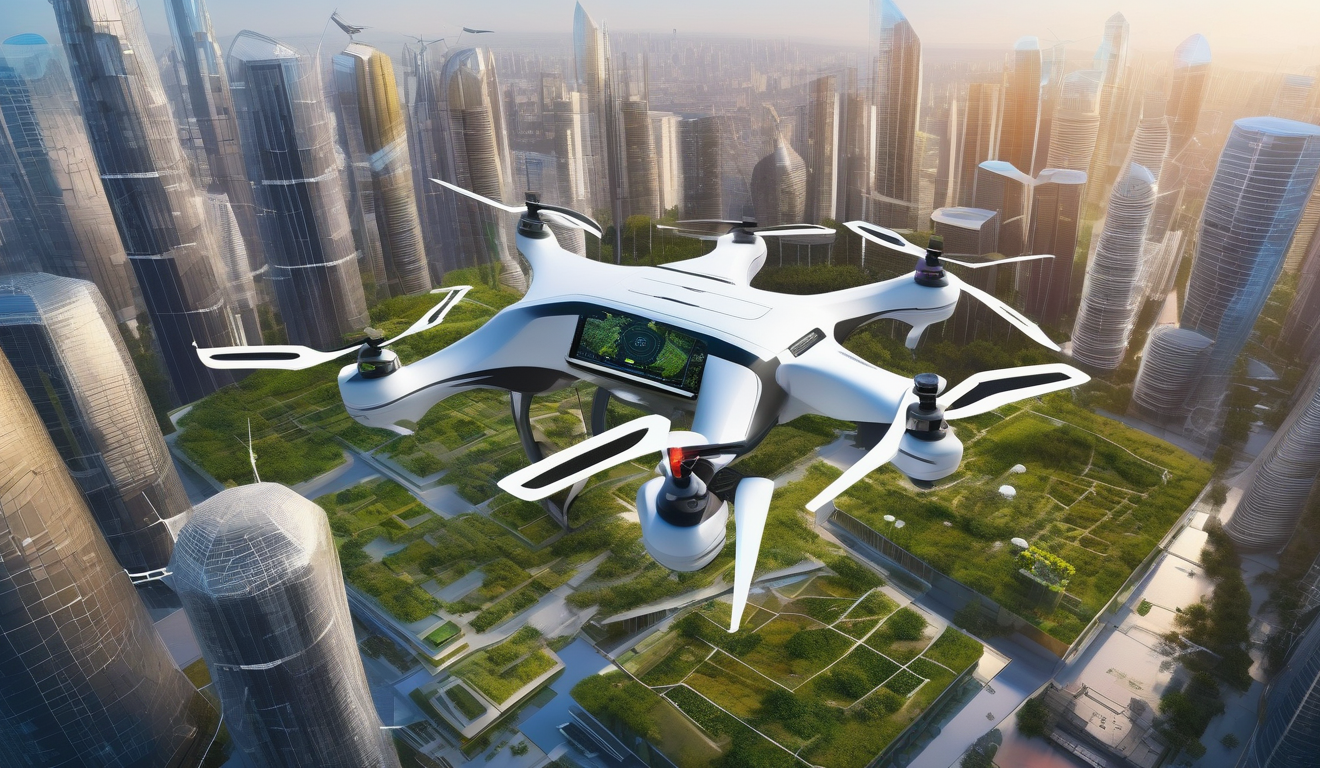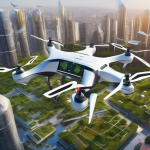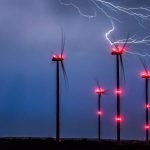The Future of Drones: Beyond Delivery Services

Drones have rapidly evolved from mere toys or novelty gadgets to powerful tools that are reshaping various industries. While many people associate drones with package deliveries, their potential extends far beyond that. Imagine a world where drones are not just delivering your online shopping but are also monitoring crops, surveying construction sites, and even assisting in disaster relief operations. This transformation is driven by technological advancements and an increasing recognition of the benefits drones can bring to various sectors.
Take agriculture, for example. Farmers are leveraging drones equipped with advanced sensors and imaging technology to monitor crop health, assess soil conditions, and optimize irrigation. This not only enhances productivity but also promotes sustainable farming practices. Similarly, in construction, drones are being used for site surveys, progress monitoring, and safety inspections, providing real-time data that can significantly reduce costs and improve efficiency.
Moreover, the environmental sector is witnessing a revolution thanks to drones. They are being deployed for wildlife monitoring, allowing researchers to track animal populations and study their habitats without disturbing them. Drones are also crucial in disaster response scenarios, where they can quickly assess damage, locate survivors, and deliver essential supplies to hard-to-reach areas. This ability to provide real-time information can be a game-changer in emergency situations.
However, as we embrace the future of drones, we must also consider the challenges that come with their widespread use. Regulatory frameworks need to evolve to address safety and privacy concerns, ensuring that drones can coexist with traditional air traffic and respect individuals’ rights. Public perception is another critical factor; understanding societal concerns about drones can help shape policies that promote positive engagement and trust in this technology.
In conclusion, the future of drones is bright and full of possibilities. As technology continues to advance, we can expect to see even more innovative applications emerge, transforming industries and enhancing our daily lives. The question is not whether drones will become a staple in our society, but rather how we will adapt to and integrate them responsibly into our world.
![The Future of Drones: Beyond Delivery Services 6 [Innovative Applications of Drones]](https://www.digitalai.news/wp-content/uploads/2025/02/the-future-of-drones-beyond-delivery-services_1.png)
[Innovative Applications of Drones]
Drones are no longer just high-tech toys or delivery vehicles; they have evolved into powerful tools that are reshaping various industries. From agriculture to construction, these flying machines are proving to be indispensable in enhancing efficiency and data collection. Imagine a farmer monitoring his crops from the sky, identifying issues before they become significant problems. This is not just a dream—it’s happening right now!
In the field of agriculture, drones equipped with advanced sensors can analyze crop health, monitor irrigation systems, and even assist in precision farming. By using multispectral imaging, farmers can gather detailed information about their fields, allowing them to make informed decisions that can lead to increased yields. This technology not only saves time but also minimizes resource waste, making agriculture more sustainable.
Moving into the construction industry, drones are being utilized for site surveys and inspections. They provide aerial views of construction sites, enabling project managers to track progress and identify potential issues early on. This can significantly reduce delays and costs associated with traditional surveying methods. In fact, a recent study showed that using drones for site inspections can cut down on project timelines by up to 20%.
Moreover, drones are making waves in environmental monitoring. They are used to survey wildlife populations, track deforestation, and even monitor pollution levels in real-time. With the ability to cover large areas quickly, drones provide invaluable data that can help conservationists make informed decisions. For example, researchers can deploy drones to monitor endangered species in remote locations, gathering critical data without disturbing the habitats.
As we look ahead, the potential applications of drones seem limitless. The integration of artificial intelligence and machine learning is set to enhance their capabilities even further. Imagine drones that can autonomously navigate complex environments, making decisions on the fly based on real-time data. The future is bright for this technology, and industries are just beginning to scratch the surface of what drones can achieve.
![The Future of Drones: Beyond Delivery Services 7 [Regulatory Challenges Ahead]](https://www.digitalai.news/wp-content/uploads/2025/02/the-future-of-drones-beyond-delivery-services_2.png)
[Regulatory Challenges Ahead]
The rapid evolution of drone technology is exciting, but it also presents a myriad of regulatory challenges that need to be addressed. As drones become more integrated into our daily lives, regulatory frameworks must evolve to ensure safety, privacy, and effective airspace management. This is no small task—imagine trying to navigate a bustling city while also ensuring that every vehicle follows the rules of the road. It’s a complex balancing act that requires collaboration among various stakeholders.
One of the primary concerns is safety. With an increase in drone traffic, the potential for accidents rises. Regulators need to establish comprehensive guidelines that dictate where drones can fly, how they should be operated, and what safety measures must be in place. For instance, no-fly zones near airports or crowded public events must be strictly enforced to prevent mishaps. Additionally, there is the challenge of ensuring that drone operators are adequately trained and certified, similar to how pilots must undergo rigorous training before taking to the skies.
Another pressing issue is privacy. Drones equipped with cameras can inadvertently invade personal spaces, raising concerns among the public. It’s crucial for regulatory bodies to create policies that protect individual privacy while still allowing for the beneficial uses of drone technology. This might include establishing guidelines on data collection and mandates for obtaining consent before capturing images or videos in private areas.
Moreover, the integration of drones into existing air traffic systems poses significant challenges. Regulatory frameworks need to adapt to manage airspace efficiently, ensuring that drones can coexist with traditional aircraft without causing disruptions. This might involve developing new technologies for air traffic management that can handle the unique demands of drone operations.
In conclusion, while the future of drones holds immense potential, navigating the regulatory landscape is a formidable challenge. It requires a proactive approach, where regulators, industry leaders, and the public work together to create a framework that fosters innovation while ensuring safety and privacy. As we move forward, it’s essential to keep these discussions at the forefront, paving the way for a future where drones can operate seamlessly and responsibly in our skies.
[Safety and Privacy Concerns]
The rapid proliferation of drones in various sectors has brought forth a myriad of safety and privacy concerns that cannot be overlooked. As drones become more integrated into our daily lives, the potential for accidents and unintended consequences grows significantly. Imagine a drone flying over your backyard, capturing footage without your consent. This scenario raises important questions about personal privacy and the boundaries of drone usage.
One of the most pressing issues is the risk of accidents. Drones, especially when operated in crowded areas, can pose serious threats to public safety. Collisions with other aircraft, power lines, or even pedestrians can lead to disastrous outcomes. It’s essential for drone operators to adhere to strict guidelines and regulations to minimize these risks. For instance, the Federal Aviation Administration (FAA) has established rules that require drone pilots to maintain a visual line of sight with their aircraft and avoid flying over people.
Furthermore, privacy concerns are amplified by the ability of drones to capture high-resolution images and videos. This capability can be misused, leading to invasive surveillance that infringes on individual rights. To address these issues, comprehensive guidelines must be developed. These guidelines should not only protect individuals’ privacy but also promote responsible drone operation. For example, operators could be required to obtain permission before flying over private properties or sensitive areas.
Public perception plays a crucial role in how drones are accepted in society. Surveys indicate that many people feel uneasy about drones flying in their neighborhoods, primarily due to fears of surveillance and accidents. To bridge this gap, it’s vital to engage the community and foster understanding through education and outreach initiatives. By informing the public about the benefits of drones and the safety measures in place, we can cultivate a more positive attitude towards this technology.
In conclusion, while drones offer immense potential for innovation, we must carefully navigate the challenges of safety and privacy. By implementing robust regulatory frameworks and engaging with communities, we can ensure that the integration of drones into our lives is both responsible and beneficial.
[Public Perception of Drones]
The public perception of drones is a fascinating blend of excitement and apprehension. While many people are thrilled about the potential of these flying machines, others harbor concerns that can hinder their widespread acceptance. Imagine a world where drones are as common as smartphones; this vision is tantalizing yet complicated by various societal factors. Understanding how the public views drones is crucial for shaping policies that not only address fears but also promote the positive aspects of drone technology.
One of the primary concerns revolves around privacy. With drones capable of capturing high-resolution images from the sky, many individuals worry about being surveilled without their consent. This fear is not unfounded—incidents of drones being used for invasive purposes have been reported, raising alarm bells among privacy advocates. To tackle this issue, it is essential to establish clear regulations that dictate how drones can be used, ensuring that personal privacy is respected.
Moreover, safety is another significant factor influencing public opinion. The idea of drones flying overhead can evoke anxiety about potential accidents or malfunctions. People often ask, “What if a drone crashes into my property?” or “How safe are these devices around my children?” Addressing these concerns requires transparent communication from drone operators and manufacturers about safety measures and operational protocols. Regular updates and educational initiatives can help demystify drone technology and reassure the public about its safety.
To foster a more positive perception of drones, community engagement strategies play a vital role. Initiatives such as public demonstrations, educational workshops, and open forums can bridge the gap between drone technology and community members. When individuals see drones in action—delivering medical supplies or conducting search and rescue missions—they can better appreciate their benefits. This hands-on experience can shift perspectives from fear to fascination.
Ultimately, the public’s perception of drones is shaped by a mix of education, regulation, and community involvement. By addressing concerns head-on and highlighting the positive impacts of drones, we can pave the way for a future where these technologies are embraced rather than feared. The key lies in fostering trust through transparency and engagement, ensuring that everyone feels comfortable with the evolving role of drones in our lives.
[Community Engagement Strategies]
Engaging communities in the conversation about drone technology is crucial for fostering a positive relationship between the public and this innovative tool. One effective strategy is to host community workshops that allow residents to interact with drones firsthand. Imagine a local park filled with families, where children can see drones in action, learning how they’re used in agriculture or environmental monitoring. Such events can demystify drone technology and showcase its benefits, making it less intimidating and more relatable.
Another important aspect is the utilization of social media campaigns. By sharing success stories of drones being used for environmental conservation or disaster relief, communities can see the tangible impacts these devices have. For instance, a short video showing a drone delivering medical supplies to a remote area can resonate deeply, highlighting the lifesaving potential of this technology.
Moreover, involving local schools in educational programs can plant the seeds of understanding early on. Schools can integrate drone technology into their science and technology curriculums, encouraging students to explore the mechanics and applications of drones. This not only raises awareness but also inspires the next generation of drone enthusiasts and operators.
Collaboration with local government and organizations can also enhance community engagement. By forming partnerships, stakeholders can create informative sessions that address safety concerns and regulatory guidelines. These sessions can include Q&A segments, where community members can voice their concerns and receive direct answers from experts. This transparency helps build trust and alleviates fears surrounding drone usage.
In addition, gathering feedback from the community through surveys or public forums can provide valuable insights into public perception. Understanding what the community values or fears about drones can guide future policies and engagement strategies. This two-way communication not only empowers residents but also fosters a sense of ownership over how drone technology is integrated into their lives.
Ultimately, the goal of these community engagement strategies is to create an informed public that feels comfortable with the presence of drones in their environment. By fostering trust and understanding, we can pave the way for smoother integration of drone technology into everyday life, ensuring that its benefits are maximized while addressing any concerns that may arise.
[Technological Advancements]
In recent years, the drone industry has witnessed a remarkable surge in technological advancements, fundamentally changing how these flying machines operate and interact with their environments. Imagine a world where drones can autonomously navigate complex landscapes, avoiding obstacles with the precision of a skilled pilot. This is not just a dream; it’s becoming a reality thanks to innovations in artificial intelligence and machine learning. These technologies enable drones to learn from their surroundings, improving their performance with each flight.
One of the most exciting developments is the integration of computer vision systems. Drones equipped with high-resolution cameras and advanced image processing algorithms can now capture stunning aerial footage while simultaneously analyzing data in real time. This capability is invaluable in various sectors, from agriculture to construction, where accurate data collection is crucial for decision-making. For example, farmers can monitor crop health and optimize irrigation systems, leading to increased yields and reduced waste.
Additionally, advancements in battery technology have significantly extended drone flight times. Previously, drones were limited by their short battery life, but innovations such as lithium-sulfur batteries are pushing the boundaries, allowing drones to stay airborne longer and cover larger areas. This is particularly beneficial in applications like environmental monitoring, where extensive data collection over vast terrains is essential.
Furthermore, the development of swarming technology is revolutionizing how drones can work together. Imagine a fleet of drones performing synchronized tasks, such as surveying a large area or delivering supplies to multiple locations simultaneously. This collaborative approach not only enhances efficiency but also opens up new possibilities in disaster response and search-and-rescue operations.
As these technological advancements continue to unfold, the future of drones looks incredibly promising. They are not just tools for delivery anymore; they are becoming integral components of various industries, enhancing productivity and safety. The sky is truly the limit for what drones can achieve as we embrace these innovations and explore their potential.
![The Future of Drones: Beyond Delivery Services 8 [Impact on Job Markets]](https://www.digitalai.news/wp-content/uploads/2025/02/the-future-of-drones-beyond-delivery-services_7.png)
[Impact on Job Markets]
The rise of drones is not just a technological marvel; it’s a revolution that is reshaping job markets across various sectors. As drones become more prevalent, they are creating a surge of new job opportunities while simultaneously posing challenges for traditional employment. This transformation is akin to the way the internet changed the landscape of work in the late 1990s—new roles emerged, while some existing positions became obsolete.
In the drone industry, we see a broad spectrum of roles emerging. For instance, the demand for skilled drone operators is skyrocketing. Companies are looking for individuals who can not only fly drones but also understand the technology behind them. This includes knowledge in areas such as data analysis, where operators must interpret the vast amounts of data collected by drones. The need for drone maintenance technicians is also on the rise as organizations seek to keep their fleets in optimal condition.
The following table illustrates some of the key job roles being created in the drone sector:
| Job Role | Description | Industry Impact |
|---|---|---|
| Drone Operator | Responsible for piloting drones and collecting data | Increased demand in agriculture, logistics, and surveying |
| Data Analyst | Analyzes data collected by drones for actionable insights | Enhances decision-making in various industries |
| Drone Technician | Maintains and repairs drone equipment | Ensures operational efficiency and safety |
However, it’s not all sunshine and rainbows. The integration of drones into existing industries can lead to job displacement, especially in sectors that rely heavily on manual labor. For instance, traditional delivery jobs may face reductions as drones become the preferred method of transport. This shift necessitates a re-evaluation of workforce skills and training programs to prepare workers for the new landscape.
As we look toward the future, it’s crucial to recognize that the drone industry is not just about technology; it’s about people. The emergence of training and certification programs will be essential to equip the workforce with the necessary skills to thrive in this new environment. By investing in education and workforce development, we can ensure that the transition to a drone-integrated economy benefits everyone.
[Training and Certification Programs]
The demand for skilled drone operators is skyrocketing, and with it comes the necessity for effective training and certification programs. These programs are essential not only for ensuring that operators are well-equipped to handle drones safely but also for maintaining high standards across the industry. As drones become more integrated into various sectors, from agriculture to emergency services, the need for qualified personnel who can operate these advanced machines responsibly has never been more critical.
Many organizations and institutions are stepping up to provide comprehensive training that covers a range of topics, including flight mechanics, regulatory compliance, and data analysis. For instance, aspiring drone pilots typically undergo a series of modules that include both theoretical knowledge and practical flight experience. This dual approach ensures that trainees are not only familiar with the technical aspects of drone operation but also understand the legal and ethical implications of their use.
Moreover, certification programs often culminate in a final assessment, which can take the form of a written exam followed by a practical flight test. Successfully passing these assessments grants operators a certification that is recognized across the industry, providing them with a competitive edge in the job market. As drone technology evolves, continuous education through advanced courses will also be vital to keep operators updated on the latest innovations and regulations.
Many training programs offer flexible learning options, including online courses and in-person workshops, allowing individuals to choose a path that best suits their schedules. Here’s a brief overview of what you might find in a typical training program:
| Program Component | Description |
|---|---|
| Theoretical Knowledge | Understanding drone technology, regulations, and safety protocols. |
| Practical Flight Training | Hands-on experience flying drones under various conditions. |
| Final Assessment | Written exam and practical test to achieve certification. |
In conclusion, as the drone industry continues to expand, investing in training and certification programs will be crucial. These programs not only enhance the skills of operators but also contribute to the safe and responsible use of drones in society. By fostering a well-trained workforce, we can ensure that the benefits of drone technology are maximized while minimizing risks to safety and privacy.
[Future Job Opportunities]
The drone industry is not just about flying gadgets; it’s a burgeoning field that promises a plethora of job opportunities across various sectors. As drones become more integrated into everyday life, the demand for skilled professionals is skyrocketing. Imagine a world where your job could involve piloting a drone to inspect infrastructure, monitor crops, or even assist in emergency services. This is not a distant future; it’s happening now!
In logistics, for instance, companies are increasingly relying on drones for efficient delivery systems. This shift is creating roles specifically for drone operators and logistics coordinators who can manage aerial deliveries. Similarly, the agricultural sector is seeing a surge in demand for drone technicians who can operate and maintain advanced agricultural drones designed for precision farming.
Moreover, the emergency services sector is another area ripe for growth. Drones are becoming essential tools in search and rescue operations, disaster relief, and firefighting. As these technologies evolve, we’ll need trained professionals who can pilot drones in high-pressure situations. This opens up opportunities for those with backgrounds in emergency management, aviation, and even environmental science.
To put things into perspective, let’s take a look at some of the emerging roles in the drone sector:
| Job Role | Description | Industry |
|---|---|---|
| Drone Operator | Pilots drones for various applications like delivery, surveying, and monitoring. | Logistics, Agriculture, Construction |
| Drone Technician | Maintains and repairs drones, ensuring they operate safely and efficiently. | All Industries |
| Data Analyst | Analyzes data collected by drones to provide insights for decision-making. | Environmental, Agriculture |
| Regulatory Compliance Specialist | Ensures drone operations meet legal and safety standards. | All Industries |
As we look ahead, it’s clear that the drone industry is not just a trend—it’s a transformative force creating jobs that didn’t exist a decade ago. The potential for economic growth and workforce development is enormous, and those willing to embrace this change will find themselves at the forefront of a new era in technology and employment.
![The Future of Drones: Beyond Delivery Services 9 [Environmental Benefits of Drones]](https://www.digitalai.news/wp-content/uploads/2025/02/the-future-of-drones-beyond-delivery-services_10.png)
[Environmental Benefits of Drones]
Drones are not just high-tech gadgets; they are becoming essential tools in the fight for environmental sustainability. Imagine a world where monitoring our planet’s health is as easy as flying a small aircraft. This is the reality that drones are creating, allowing us to gather crucial data while minimizing our impact on the environment. From wildlife conservation to precision agriculture, the applications are as diverse as they are impactful.
One of the most notable benefits of drones is their ability to monitor wildlife and natural habitats. Traditional methods of tracking animals often involve invasive techniques that can disturb ecosystems. Drones, on the other hand, provide a non-intrusive way to observe wildlife from above. They can cover large areas in a fraction of the time it would take on foot, allowing researchers to gather data on animal populations and behaviors without causing disruption.
In agriculture, drones are revolutionizing the way farmers approach crop management. By using advanced sensors, drones can collect data on soil health, crop health, and even moisture levels. This information allows farmers to make informed decisions about where to allocate resources, ultimately leading to more efficient use of water and fertilizers. As a result, farmers can not only increase their yields but also reduce their environmental footprint. For instance, a study showed that precision agriculture using drones can reduce water usage by up to 30%.
| Application | Benefit |
|---|---|
| Wildlife Monitoring | Non-invasive tracking and data collection |
| Agricultural Management | Improved resource allocation and reduced waste |
| Disaster Response | Rapid assessment and supply delivery |
Moreover, drones play a critical role in disaster response and recovery efforts. During natural disasters, they can quickly assess damage, identify hazards, and even deliver essential supplies to affected areas. This capability not only saves time but can also save lives. For example, after a hurricane, drones can map out flooded areas, helping emergency services to navigate more effectively and reach those in need.
In summary, the environmental benefits of drones are profound and far-reaching. By enhancing our ability to monitor and manage natural resources, drones are paving the way for a more sustainable future. As technology continues to advance, we can expect even greater innovations that will further bolster our efforts to protect the planet.
[Monitoring and Conservation Efforts]
Drones are revolutionizing the way we approach monitoring and conservation efforts around the globe. Traditionally, wildlife monitoring and environmental assessments required extensive manpower and resources, often resulting in limited data collection and analysis. However, with the advent of drone technology, we can now gather real-time data and obtain aerial perspectives that were once unimaginable. Imagine being able to survey vast stretches of forest or coastline in just a few hours, rather than days or weeks!
One of the most significant advantages of using drones in conservation is their ability to cover large areas quickly and efficiently. For instance, drones equipped with high-resolution cameras and thermal imaging can track wildlife movements, monitor habitat changes, and even detect illegal poaching activities. This capability not only enhances our understanding of ecosystems but also allows conservationists to respond swiftly to emerging threats.
Let’s consider some of the specific ways drones are making a difference:
- Wildlife Monitoring: Drones help researchers track animal populations without disturbing their natural habitats, providing insights into behavior and migration patterns.
- Habitat Mapping: Aerial imagery collected by drones enables more accurate mapping of habitats, which is crucial for planning conservation strategies.
- Data Collection: Drones can collect data on vegetation health, soil conditions, and water sources, which are essential for effective land management.
Moreover, the data gathered by drones can be analyzed using advanced software, allowing for the creation of detailed reports and visualizations. These insights not only aid in immediate conservation efforts but also contribute to long-term strategies aimed at preserving biodiversity and combating climate change.
In conclusion, the integration of drone technology into monitoring and conservation efforts is not just a trend; it’s a game-changer. As we continue to harness this technology, we can expect to see even greater advancements in our ability to protect natural resources and ensure a sustainable future for our planet.
[Disaster Response and Recovery]
In the chaotic aftermath of a disaster, every second counts. Drones have emerged as a game-changer in disaster response and recovery operations, offering unparalleled speed and efficiency. Imagine a scenario where traditional methods of assessing damage are hindered by obstacles or hazardous conditions. This is where drones swoop in, equipped with advanced technology to provide real-time aerial imagery and data. They can quickly survey affected areas, allowing emergency responders to prioritize their efforts effectively.
One of the most significant advantages of drones is their ability to access hard-to-reach locations. Whether it’s a flooded area, a collapsed building, or a wildfire zone, drones can navigate these environments without putting human lives at risk. This capability not only enhances safety but also accelerates the pace of recovery. In fact, studies have shown that using drones can reduce the time needed for damage assessment by up to 70%, allowing for quicker deployment of resources and aid.
Furthermore, drones can be equipped with various tools for specific tasks. For instance, thermal imaging cameras can identify hotspots in disaster-stricken areas, while delivery drones can transport essential supplies like food, water, and medical kits directly to those in need. This versatility is crucial in a crisis when every resource matters. Below is a table highlighting some of the key roles drones play in disaster response:
| Role | Description |
|---|---|
| Damage Assessment | Provides real-time aerial views to evaluate the extent of damage. |
| Search and Rescue | Locates missing persons using thermal imaging and GPS technology. |
| Supply Delivery | Transports critical supplies to inaccessible areas. |
| Infrastructure Monitoring | Inspects roads, bridges, and utilities for safety and integrity. |
As we look to the future, the integration of drones in disaster response is not just a trend; it’s becoming a standard practice. Their ability to gather data rapidly and deliver aid efficiently underscores their potential to save lives and streamline operations. It’s clear that in the face of adversity, drones are not just tools; they are lifelines.
Frequently Asked Questions
- What are some innovative applications of drones?
Drones are being used in various fields like agriculture for crop monitoring, construction for site inspections, and environmental monitoring for wildlife tracking. Their ability to collect data efficiently is transforming how industries operate.
- What regulatory challenges do drones face?
As drone technology advances, regulations must evolve to address safety, privacy, and airspace management. This ensures that drones can be integrated responsibly into our daily lives while encouraging innovation.
- How do drones impact job markets?
The rise of drones is creating new job opportunities in areas such as drone operation, maintenance, and data analysis. However, this shift may also challenge traditional employment in some sectors.
- What are the environmental benefits of using drones?
Drones contribute to environmental sustainability by enhancing wildlife monitoring, enabling precision agriculture, and improving disaster response efforts. They provide real-time data that helps in effective resource management.
- How can communities engage with drone technology?
Community engagement through education and outreach initiatives can foster trust and understanding around drone usage. This helps address public concerns and paves the way for smoother integration into everyday life.
- What safety and privacy concerns are associated with drones?
With the increasing use of drones, there are significant safety and privacy concerns. Comprehensive guidelines are needed to protect individuals and property while promoting responsible drone operation.
- What future job opportunities exist in the drone sector?
Emerging roles in the drone sector include positions in logistics, agriculture, and emergency services. As the industry grows, so does the potential for economic development and workforce expansion.













